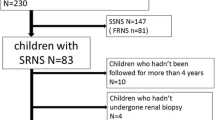Abstract
The aim of this study was to examine the compromise of proximal tubule cells in steroid-resistant nephrotic syndrome patients with a histologic diagnosis of focal segmental glomerulosclerosis (FSGS) through assessment of the urinary levels of β2-microglobulin (β2M) and N-acetyl-β-d-glucosaminidase (NAG) during active disease and remission over a follow-up period of 3 years. We studied 34 children with nephrotic syndrome: 12 with steroid-resistant nephrotic syndrome (SRNS) and massive proteinuria, 7 with steroid-dependent nephrotic syndrome (SDNS) and 15 with steroid-sensitive nephrotic syndrome (SSNS). Of the SSNS patients, 8 children were in remission (RM) and 7 were in relapse (RL). Seven healthy children were included as controls. Urinary β2M, measured by enzyme-linked immunosorbent assay, was significantly increased in the SRNS group as compared to the SDNS group (P<0.01), SSNS in remission (P<0.01), and controls (P<0.01). There were no differences between the SRNS group and SSNS in relapse. Analysis of urinary N-acetyl-β-d-glucosaminidase (U-NAG) by colorimetric assay showed significantly higher values in the SRNS group of patients than in SDNS, SSNS, and control groups. A positive correlation between U-NAG and proteinuria was demonstrated (r=0. 73, P<0.01). The SRNS group of patients (n=12, 11 with a histologic diagnosis of FSGS and one with diffuse mesangial proliferation) was treated with the same protocol of i.v. methylprednisone and oral cyclophosphamide. Long-term follow-up showed a progressive decrease in U-β2M and U-NAG excretion to control values in the 3rd year, except in one patient who did not respond to the treatment. In the FSGS patients, evaluation of the contribution of structural interstitial histological abnormalities, including each of the histological parameters considered in interstitial scarring to the functional tubule abnormalities assessed by β2M and NAG excretion, was performed by multiple regression analysis. The r 2 values for β2M and NAG were 53.99%, P=0.19, and 57.90%, P=0.14, respectively; neither was significant. We conclude that: (1) proximal tubule cell dysfunction, partially affected by massive albuminuria, may account for the higher values of β2M and NAG excretion in the SRNS patients and (2) urine β2M and NAG levels are not helpful in identifying histological evidence of structural tubulointerstitial damage in children with steroid-resistant nephrotic syndrome.
Similar content being viewed by others
Author information
Authors and Affiliations
Additional information
Received: 28 December 1999 / Revised: 20 July 2000 / Accepted: 21 July 2000
Rights and permissions
About this article
Cite this article
Vallés, P., Peralta, M., Carrizo, L. et al. Follow-up of steroid-resistant nephrotic syndrome: tubular proteinuria and enzymuria. Pediatr Nephrol 15, 252–258 (2000). https://doi.org/10.1007/s004670000472
Issue Date:
DOI: https://doi.org/10.1007/s004670000472




